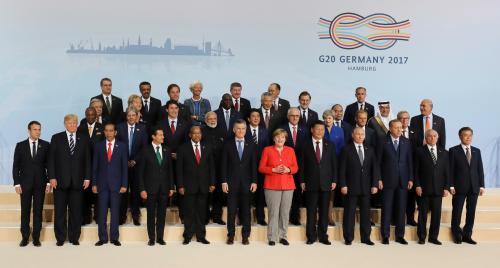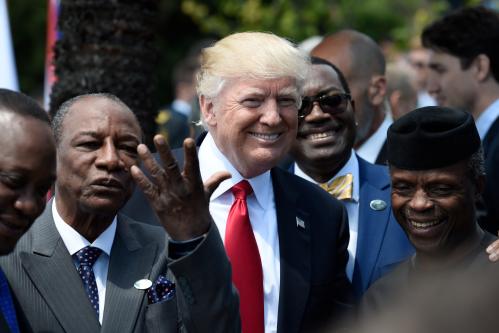Below is a viewpoint from Chapter 6 of the Foresight Africa 2018 report, which explores six overarching themes that provide opportunities for Africa to overcome its obstacles and spur inclusive growth. Read the full chapter on the changing nature of Africa’s external relationships here.
Since 2000, six FOCAC (Forum on China-Africa Cooperation) summits have been held at three-year intervals, with the next one scheduled for 2018 in Beijing if the tradition is to continue. FOCAC has been the primary institutional platform and mechanism for the economic cooperation between China and African states. Perhaps as a part of President Xi Jinping’s prestige diplomacy, the level of commitment China made at the 2015 summit in Johannesburg was surprisingly high: The $60 billion funding promised tripled the previous $20 billion commitment made during the 2012 FOCAC Summit.[1]
These funds are expected to help address the bottleneck in Africa’s economic and social development. In 2015, Xi announced 10 comprehensive and ambitious plans covering industrialization, agricultural modernization, trade and investment, and public health, among others. The implementation of the Chinese commitments in the past two years is indicative of the priority and pace of China’s engagement in Africa in 2018 if China is to complete them before the next FOCAC Summit.
3 priority areas of China’s 2015 FOCAC commitment: industrialization, agricultural modernization, and infrastructure
China has been ambitious in engaging Africa. In 2018, China will keep promoting the development of industrial parks and attracting investors for them as its feature programs for African industrialization. China has also emphasized industrial partnering and industrial capacity cooperation in Africa—committing to facilitate Chinese private investment, provide technical assistance, and train at least 200,000 local workers. Already, in Ethiopia, China completed the $250 million Hawassa Industrial Park in nine months between 2015 and 2016. According to Chinese officials, the park has attracted 15 leading textile and garment companies and six are already exporting to the international market. The China Civil Engineering Construction Company (CCECC) is building three other industrial parks in the country, also financed by Chinese loans and investment. In Kenya, China’s Guangdong New South Group started the country’s first private industrial park in Uasin Gishu in July 2017 at the cost of $2 billion. This park will be an important component for Kenya’s Zhujiang Special Economic Zone (SEZ), which is partially inspired by China’s SEZ development model. In 2018, China will keep promoting the development of industrial parks to support Africa’s industrialization.
One prominent feature of China’s agricultural aid to Africa has been through agricultural technology demonstration centers, which integrate with local agricultural industries, but also aim to create solid footholds for Chinese companies in the new markets.
In terms of Sino-African agricultural modernization cooperation, China has targeted improving African agricultural capacity and productivity primarily through experience-sharing, technology transfer, encouraging Chinese agricultural investments in Africa, and setting up new exchange frameworks and programs to bring Chinese experts to these African countries. One prominent feature of China’s agricultural aid to Africa has been through agricultural technology demonstration centers, which integrate with local agricultural industries, but also aim to create solid footholds for Chinese companies in the new markets. As of 2017, 23 demonstration centers are operating across the continent. In addition to demonstration centers, just recently China agreed to give Zambia new concessional loans to improve its agricultural capacity as well as skills training and increased Chinese investment in the sector. With South Africa, China signed new agricultural sector-related agreements that aimed at facilitating the exchange of experts and technology between the two countries. Similar agreements have surfaced with Nigeria as well. It is foreseeable that China will be pushing agricultural development as a key agenda item in 2018, and hopefully across the continent rather than on a few priority countries.
China’s interest in infrastructure goes beyond an increase in trade and population flow via traffic, but also in improving civil aviation traffic capacity, power grids, telecommunication networks, and human resources training. Importantly, China’s 2015 commitment on infrastructure focuses on the cooperation in railway, highway, and port projects through a variety of financing methods. The successful May 2017 launch of the Chinese-built and financed Mombasa-Nairobi Standard Gauge Railway (the Madaraka Express) in Kenya will only be continued in years to come: If things proceed smoothly, the Mombasa-Nairobi line will eventually link Kenya, Tanzania, Uganda, Rwanda, Burundi, and even South Sudan and Ethiopia.
At the current rate, the China-Africa Industrial Capacity Cooperation Fund is unlikely to achieve the goal of $10 billion financing by the end of 2018.
Looking into 2018, China’s infrastructure interests will increasingly diversify into the field of power generation and transmission. Indeed, without electrical power, an industrialization plan will only remain a blueprint. Associated with the power shortage, China seems to echo some African countries’ call for the development of renewable energy as the alternative source, which might be counter-intuitive given China’s pragmatic and highly cost-conscious approach toward investment in Africa.
Do the numbers add up?
The most intriguing question in assessing China’s fulfillment of the 2015 FOCAC commitment lies in the numbers: How much of the committed financing has been disbursed? The answer to that question will determine the level and pace of Chinese financing in 2018. Despite the impressive progress China has made on various fronts, the statistics from the Chinese side are vague and inconclusive. For example, according to the People’s Daily, 243 cooperation agreements were signed between December 2015 and July 2016, with a total amount of $50.7 billion, including $46 billion for direct investments and commercial loans by Chinese companies. When interpreting the numbers, the Chinese vice foreign minister did not explain what percentage of the $50.7 billion came from the $60 billion official commitment of financing from the Chinese government. Instead, the official explanation is that the $60 billion commitment by the Chinese government had achieved a multiplier effect by inspiring private capital and commercial financiers. Positive as that sounds, it does not answer the question.
Some statistics from China are less inspiring. The China-Africa Industrial Capacity Cooperation Fund, swiftly established after Xi’s announcement in Johannesburg and with the $10 billion start-up capital from the Chinese government, started operations in January 2016. However, after 18 months of formal operation, the fund only approved six projects with a total investment of $542 million, among which only four received disbursed investment of $248 million. According to its officials, the fund prioritizes risk management and mid- to short-term equity investment over speed and volume of investment. In particular, the fund cited the dropping investment in sub-Saharan Africa and the plummeting interests by Chinese companies due to the domestic economic slowdown as the key factors influencing the pace of the fund. At the current rate, the China-Africa Industrial Capacity Cooperation Fund is unlikely to achieve the goal of $10 billion financing by the end of 2018. China might play the word game by pointing out that the capital is indeed disbursed to the fund, yet that hardly counts as funding provided to Africa.
Given the popularity of PPP for China’s discussion of overseas investment, such as for the One Belt, One Road Initiative, it will be highly interesting whether China will experiment more with PPP in 2018.
Statistics on the $35 billion committed concessional loans are even less readily available. In the FOCAC Johannesburg Achievements Implementation Coordinators Conference held in Beijing six month later, it was disclosed that the Chinese Export-Import Bank had approved $4.3 billion in concessional loans to Africa after the 2015 FOCAC Summit. At that rate, China should be able to meet the $35 billion threshold by the end of 2018.
One issue worth observing in 2018 is how China applies and accounts for the PPP model (public-private partnership) for new investment in infrastructure projects in Africa. Chinese players have taken note of various African governments’ interests in the PPP model to meet the funding gap in infrastructure development. However, beyond pure observation, real participation by Chinese companies in such projects have yet to pick up speed. However, given the popularity of PPP for China’s discussion of overseas investment, such as for the One Belt, One Road Initiative, it will be highly interesting whether China will experiment more with PPP in 2018.
2018 will be the last year for China to complete its Johannesburg commitments. China has been making steady progress in meeting its financing promises in areas such as industrialization, agricultural development, and infrastructure. Given its current pace, meeting most of the $60 billion financing commitment should be on track. However, China will have to make substantial progress under specific categories, such as the China-Africa Industrial Capacity Cooperation Fund in 2018, to meet its promise. New focuses, such as power generation/transmission and the PPP model will be interesting areas to observe in 2018 to identify the next steps of China’s priority in Africa.
footnote
- The $60 billion includes $5 billion for grants, $35 billion for concessional loans and export credits, $5 billion each for the China-Africa Development Fund and the Special Loan for the Development of African Small- and Mid-Sized Enterprises, and $10 billion for a China-Africa Industrial Capacity Cooperation Fund.







Commentary
Foresight Africa viewpoint – China’s engagement in Africa: What can we learn in 2018 from the $60 billion commitment?
January 30, 2018